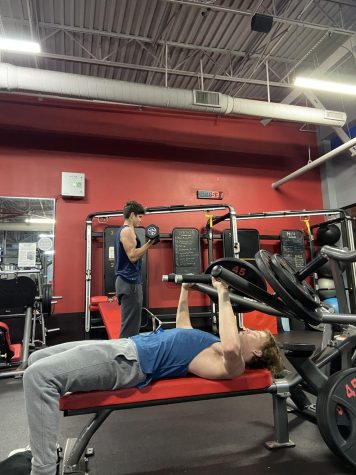Pro-Teens: The Rise of Bodybuilding Among Adolescents
May 3, 2023
It was 2:00 a.m. and sophomore Eric Moelter was in his kitchen precisely measuring out over 1,000 calories of oatmeal, whey protein and ice cream.
Most teenagers, of course, were in bed. But Moelter is not most teenagers.
This scene – which Moelter recalled later – is a common occurrence for him, who sometimes needs a middle-of-the-night smoothie to reach his goal of 4,000 calories per day.
Moelter has been bodybuilding for about two years, taking extreme measures for results along the way.
Bodybuilding, considered by its competitors to be a combination of sport and art, blew up in the 1980s and has been on the decline ever since.
But as social media has taken a hold of American youth, bodybuilding has once again muscled its way into the minds of the future.
Influencers like Noel Deyzel and Alex Eubank have given teens a new fitness standard, but not without the use of steroids.
Even though the dangers of steroids are well known, and laws exist to prevent their use by minors, doctors are worried that juveniles will be susceptible to the temptation of such forbidden fruit.
Steroids have become glorified to the point that kids are ignoring medical professionals for the goal of becoming as large as possible.
“There are kids coming in, no older than 15 or 16, struggling with body dysmorphia because of the things they’re seeing online,” Dr. Ian Michalak, an adolescent psychiatrist at the University of Tennessee Health and Science Center in Memphis, said in an interview.
According to the Diagnostic and Statistical Manual of Mental Disorders, a person with muscle dysmorphia is preoccupied with the idea that their body is too small or not muscular enough.
“They’re healthy, they’re active, but it’s still not enough,” said Michalak. “But they’re convinced that they aren’t enough because they don’t look like the people they look up to.”
Individuals suffering from body dysmorphia constantly criticize themselves despite words of affirmation from others.

“I work out so that someday I can feel muscular enough,” said Drew DiBiase, a junior who has been lifting for a few years.
“People tell me I look good, and the scale says I’ve lost weight, but I still look in the mirror and want to be bigger.”
Steroid usage is typically the primary cause of body dysmorphia, but not all lifters look to them as a solution. Some find their fix in the form of more widely available supplements.
Kristen Kanner, a dietician at Fuller Life Nutrition, is constantly asked about creatine usage.
“Creatine is not objectively bad for you — it’s a naturally occurring substance,” said Kanner. “But when you’re pumping in high dosages, your organs can’t always handle processing that, especially for a developing body.”
The negative effects of excessive creatine usage can range from stomach cramps to organ damage, said Kanner, who added that the substance even can lead to kidney failure like that of alcoholism.
Due to his daily combination of creatine and pre-workout supplements, Moelter, the sophomore bodybuilder on the high-calorie diet, must sometimes take melatonin to sleep at night.
Another important component of the bodybuilder’s lifestyle is diet.
International Federation of Body Building competitor Evan Centopani, known for his popular food-centric lifting channel on YouTube, takes in around 3,500 calories a day, according to a video published in 2019.
Though greater than the average human intake, this is still healthy because of his balance of micro and macronutrients and meticulously planned meals, Centopani said in the video.
However, many teens attempting to replicate his eating habits are doing so haphazardly, not realizing the two main advantages Centopani has on them.
First, Evan Centopani is a fully-grown man. Second, and most importantly, he understands proper food management.
According to Kanner, the tendency in bodybuilding diets among young people is to overload macronutrients, such as protein, fats and carbohydrates, and ignore the micronutrients that provide the body with crucial vitamins.
So, although they are meeting their daily calorie intake goals – 3,500 for DiBiase when he is trying burn fat and 4,000 for Moelter when he is trying to pack on muscle – they’re doing so primarily off foods like ground beef, chicken with rice and protein shakes, losing out on important micronutrients in favor of high calorie items.
Because of this, the micronutrients they do work into their diets can be so important that even just a few days without them could lead to health problems down the road, according to Kanner.
Moelter and DiBiase said they realize the importance of balancing their diets to keep their bodies healthy, but many high school lifters are not well versed in food science.
“I just kind of eat,” said senior Chris Giannini, who regularly lifts weights. “I’m not on any huge calorie intake or anything, so I’ve never felt the need to be super technical with my diet.”
Although the risks of the bodybuilding lifestyle can be serious, members of the community said the benefits across other aspects of their lives have been amazing.
“I was always pretty fat, so my teammates used to call me ‘Chubs,’” said DiBiase. “I was pretty proud when I got the nickname ‘Big Dog’ because it meant I had improved from how I used to be.”
Moelter also started lifting to deal with weight issues, but his were a bit different.
“I was pretty chubby until about the 8th grade,” he said, “and then I started running a lot and not eating, so I got super skinny. The gym has been my way of finding a great balance.”
Another thing DiBiase attributes to his lifting is his improved attitude.
“I think as soon as you see a positive change in yourself, the late nights and early mornings, the bulk meals and cut weeks, the heavy sets and everything else you go through, it’s all worth it,” said DiBiase.
